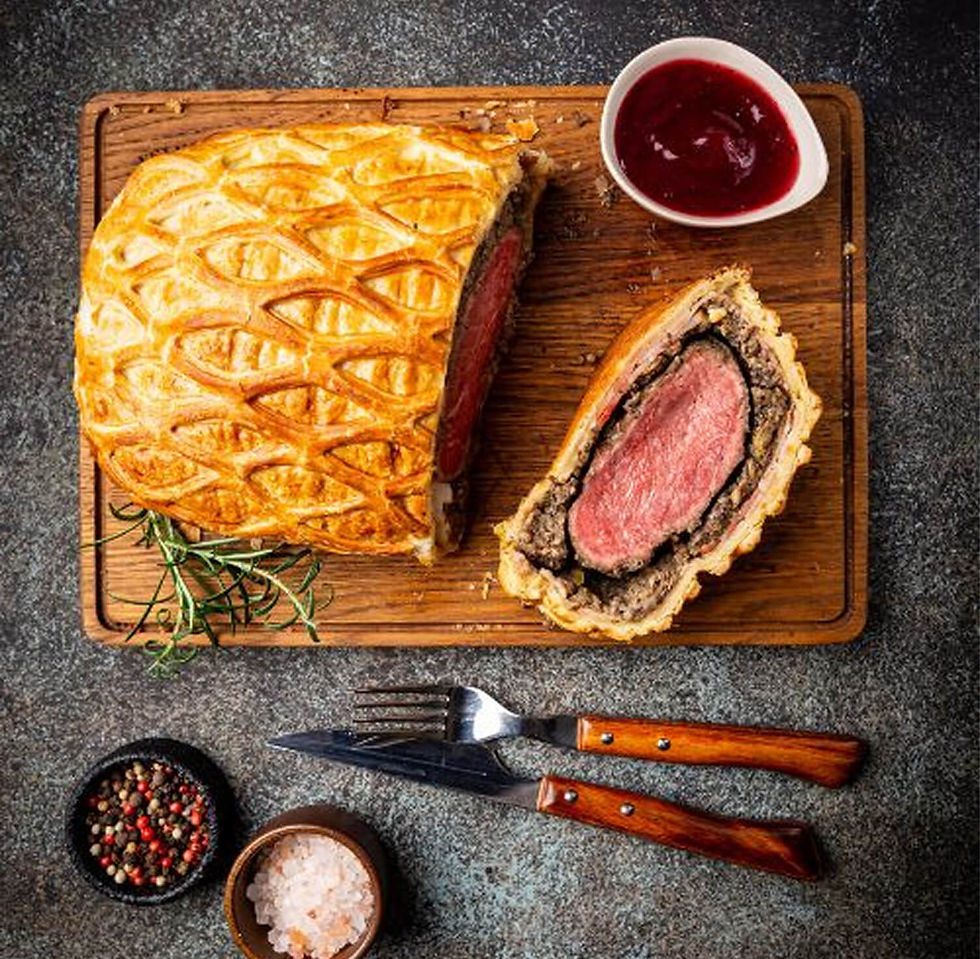Risotto—A Deliciously, Creamy Dish
- May 16, 2021
- 5 min read

Risotto is a creamy rice dish that originated in the rice-growing regions of Northern Italy.
Legend has it this dish dates back to 1574, when a stained-glass maker working on Milan’s cathedral developed yellow-tinted glass by adding saffron to his pigments. Since saffron turned his glass into a magnificent hue, the glassmaker added the spice to a rice dish served at his boss’s daughter’s wedding, creating “risus optimus”—Latin for excellent rice. From that day forward, rice with a yellow hue has been called “risotto alla Milanese.”
While most of us associate Italy with wine and olive oil, Italy has been growing rice since the 14th century. No doubt brought from the east on ships by Venetian and Genoese merchants, Italian rice cultivation can be documented back to 1475. Italians now grow rice in the Lombardy, Piedmonte, and Veneto regions.
While most food historians believe risotto is a peasant dish, turned sophisticated, the Italians are not the least bit hush-hush about the secrets to making good risotto. The first secret is, of course, the rice. Now, you can’t use that box of Uncle Ben’s® sitting in your pantry. A creamy risotto requires Italian rice—it is short with a barrel shape, much different than long-grain rice.
Italian rice has two characteristics—a very soft starch on the outside that melts away from the kernel, creating a creamy texture, and a very hard inner starch that stays firm, leaving the finished product “al dente”, or firm to the bite. There are four varieties of rice that will make a good risotto: comune, semifino, fino, and superfino. The type most commonly used for risotto is Arborio, a superfino variety typically available in the United States.
The second secret is the technique. Risotto is made by braising rice, which allows the grains to absorb the flavors of the cooking liquid, usually broth, along with other ingredients. The rice used in this preparation lends its starches to the cooking liquid—the results, a rich consistency that resembles a heavy cream sauce. The process begins by toasting the rice in a “soffrito”, a combination of chopped vegetables like onion, garlic, and carrots, before adding the broth in slowly, usually one cup at a time. While not particularly difficult to prepare, a good risotto requires patience and your undivided attention for 20 to 25 minutes, while you stir it in a rhythmic manner.
What makes risotto distinctive is the combination of local ingredients that give it character. In the Piedmonte region, Italians add truffles and red Barolo wine. In Venice, seafood is a mainstay. Risotto is versatile. You can add any ingredients, and the cooking technique will blend and smooth out the flavors into a deliciously creamy dish. Following are two of my preparations for risotto.
Chicken Risotto with Asparagus and Garden Peas Makes 4 Entrée Servings
Serve with a green salad and a loaf of bread.
For the chicken: 2 tablespoons brown sugar 2 tablespoons salt 1 teaspoon large grind black pepper 4 boneless, skinless chicken breasts
In a small bowl, mix brown sugar, salt, and pepper. Coat chicken breasts evenly with the brown sugar mixture. Place chicken breasts in a medium-sized bowl, cover with plastic wrap, and refrigerate for at least 2 hours, or as long as 6 hours. Grill chicken breasts over medium heat, turning once, until meat is opaque throughout and juices run clear, about 10 to 12 minutes. Remove from the grill and slice thinly. Set aside.
For the risotto: 1 can (14 ½-ounces) chicken broth 1 cup water 4 tablespoons butter 1 teaspoon minced garlic 1 medium yellow onion, chopped 1 leek (white parts only), thinly sliced 2 cups Arborio rice 1 can (14 ½-ounces) chicken broth ½ cup chardonnay 1 cup thin asparagus, cut into 1-inch pieces 1 cup freshly shelled small peas or petite frozen peas 3 tablespoons fresh chives, thinly sliced ½ cup grated Parmesan cheese 4 tablespoons butter Sea salt to taste Large grind black pepper to taste
In a large saucepan, bring 1 can chicken broth plus 1 cup water to a simmer over medium heat. Add 4 tablespoons butter, garlic, onion, and leek and cook, stirring occasionally, until onion is soft, about 5 minutes. Add Arborio rice and stir until the grains are coated with butter. As liquid cooks down, add the second can of chicken broth ½ cup at a time and cook, stirring continually, until Arborio rice absorbs all the liquid, about 20 to 25 minutes. Adjust the heat as necessary so that the mixture maintains a gentle boil. Add wine, asparagus, peas, chives, Parmesan cheese, and 4 tablespoons butter. Mix and cook only long enough to heat through, about 2 minutes. Season with salt and pepper to taste. Sprinkle with additional Parmesan cheese if desired. Serve immediately.
Shopping for garden or English peas: Select garden or English peas with bright green, velvety pods. Discernible pearl-shaped peas should barely fill the pod. Avoid overgrown peas that are flattened against each other like teeth. Do not buy immature peas that are flat, dark green, or wilted. Avoid overgrown peas that are swollen and freckled with gray spots. A yellow color indicates age or damage.
Storing garden or English peas: Peas are best eaten immediately after they are picked. When stored in plastic bags and refrigerated, garden peas will last 3 to 4 days.
Preparing garden or English peas: To shuck garden or English peas, pinch off the stem and pull the string down the side of the pod. Using your thumb, push the peas out. Discard pods.
Chicken and Artichoke Risotto Makes 4 Entrée Servings
6 slices bacon ¼ cup pan drippings 1 cup white onion, chopped 1 pound boneless, skinless chicken breasts, cut into 1-inch pieces 2 cups Arborio rice 1 cup white wine 2 cans (14 ½-ounces) chicken broth, divided 1 can (14 ½-ounces) water-packed artichoke hearts, drained and quartered ½ cup sour cream 1 package (½-ounce) fresh chives, chopped ¾ cup large grated Parmesan cheese
In a heavy large skillet, cook bacon over medium heat until crisp, about 5 minutes. Transfer bacon to paper towels to drain. When dry, crumble bacon into bite-size pieces and set aside. Using ¼ cup pan drippings, add onion and chicken cubes and sauté until onions are soft and chicken is cooked through. Add Arborio rice and stir until well coated. Add ½ cup white wine, stirring constantly, until Arborio rice has completely absorbed the liquid. Add remaining ½ cup wine and continue stirring until rice has absorbed all the liquid. Follow this same process with chicken broth, adding ½ cup at a time until all liquid has been absorbed. Reduce the heat to low, stirring frequently. Adjust the heat as necessary so that the mixture maintains a gentle boil. Continue to ladle in ½ cup broth at a time, stirring continually, and cook until liquid has been absorbed, all chicken broth has been added, and Arborio rice is tender. Add bacon pieces, artichoke hearts, sour cream, chives, and grated Parmesan cheese. Mix well. Serve immediately.
Cooking tip for making a creamy risotto: Although labor intensive, it is important to add the liquid ½ cup at a time. Stir continually until all the liquid is absorbed. Then add another ½ cup. This technique results in rice that is delectably creamy while the grains remain separate and firm.
Carol Ann

Carol Ann Kates is the award-winning author of cookbook, Secret Recipes from the Corner Market and Savvy Shopping Tips. She’s an expert in how to shop, select, and store produce for maximizing home cooking outcomes and minimizing time and money spent. As a former supermarket and deli operator, Carol Ann shares grocery-insider wisdom—the same expertise you used to receive when patronizing a mom-and-pop establishment. Contact her at KatesCarol@aol.com and explore her website, www.CarolAnnKates.com.
@2021 Carol Ann Kates All Rights Reserved Carol Ann Kates is the award-winning author of cookbook, Secret Recipes from the Corner Market, and Expert in How to Shop, Select, and Store Produce for Home Cooking.
1
Searing the Beef
Sear beef fillets on high heat for 2 minutes per side to form a golden crust. Let it cool before proceeding to keep the beef tender.
1
Searing the Beef
Sear beef fillets on high heat for 2 minutes per side to form a golden crust. Let it cool before proceeding to keep the beef tender.
1
Searing the Beef
Sear beef fillets on high heat for 2 minutes per side to form a golden crust. Let it cool before proceeding to keep the beef tender.
1
Searing the Beef
Sear beef fillets on high heat for 2 minutes per side to form a golden crust. Let it cool before proceeding to keep the beef tender.
Notes



1
Season the good fresh beef fillets with salt and black pepper. Heat olive oil in a pan over high heat and sear the fillets for 2 minutes per side until it fully browned. Remove the beef from the pan and brush with a thin layer of mustard. Let it cool.



1
Season the good fresh beef fillets with salt and black pepper. Heat olive oil in a pan over high heat and sear the fillets for 2 minutes per side until it fully browned. Remove the beef from the pan and brush with a thin layer of mustard. Let it cool.



1
Season the good fresh beef fillets with salt and black pepper. Heat olive oil in a pan over high heat and sear the fillets for 2 minutes per side until it fully browned. Remove the beef from the pan and brush with a thin layer of mustard. Let it cool.



1
Season the good fresh beef fillets with salt and black pepper. Heat olive oil in a pan over high heat and sear the fillets for 2 minutes per side until it fully browned. Remove the beef from the pan and brush with a thin layer of mustard. Let it cool.
Instructions
Quality Fresh 2 beef fillets ( approximately 14 ounces each )
Quality Fresh 2 beef fillets ( approximately 14 ounces each )
Quality Fresh 2 beef fillets ( approximately 14 ounces each )
Beef Wellington

Beef Wellington
Fusion Wizard - Rooftop Eatery in Tokyo
Author Name

Beef Wellington is a luxurious dish featuring tender beef fillet coated with a flavorful mushroom duxelles and wrapped in a golden, flaky puff pastry. Perfect for special occasions, this recipe combines rich flavors and impressive presentation, making it the ultimate centerpiece for any celebration.
Servings :
4 Servings
Calories:
813 calories / Serve
Prep Time
30 mins
Prep Time
30 mins
Prep Time
30 mins
Prep Time
30 mins










Comments